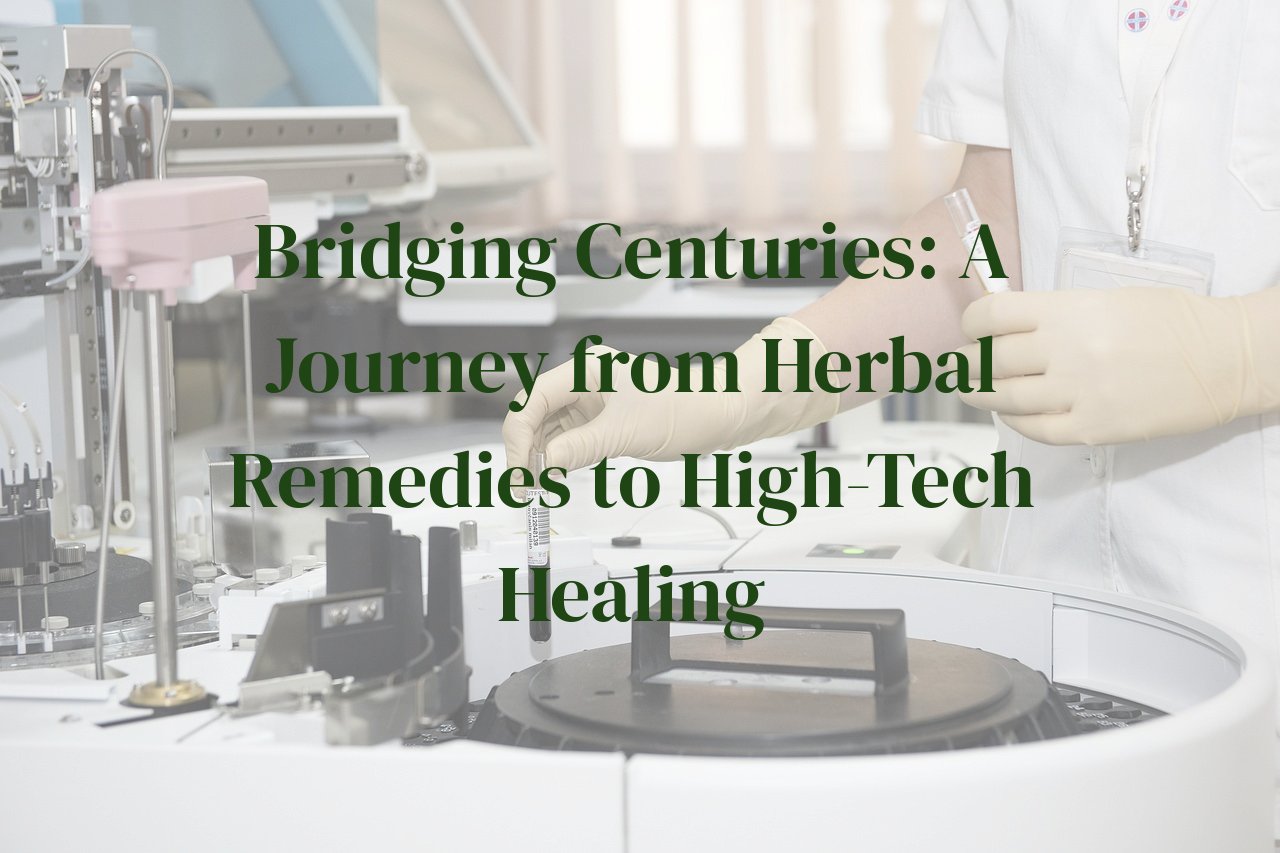
Embark on an explorative narrative that intersects the pathways of time-tested ancient healing traditions with the sophistication of modern medical innovations. In this comprehensive examination, we not only delve into the practices that have stood the test of time but also scrutinize how they parallel, contrast, and occasionally intertwine with contemporary medical interventions. This post promises to uncover the intricacies of past and present healthcare, offering you practical insights into their respective benefits and limitations. By the end, readers will have gleaned a unique perspective on the evolution of medicine, potentially enriching their own health practices with a blend of historical wisdom and modern science.
Table of Contents
The Tapestry of Traditional Healing: Understanding Ancient Practices
The realm of traditional healing is as vast and varied as the cultures and histories that it springs from. My fascination with this intricate tapestry began during a childhood spent under the watchful eyes of my grandmother, who firmly believed in the healing powers of plants and earth. Each herb in her garden was more than just foliage; it was a repository of healing, a living medicine cabinet cultivated through generations of knowledge and care. With a touch of nostalgia, I recall the fragrant bundles of lavender for easing headaches and the soothing chamomile teas for a night of peaceful sleep.
Delving deeper into these ancient practices uncovers a veritable pharmacopeia of natural remedies. In the Amazonian rainforests, shamans have long used Cat’s Claw to reduce inflammation, while Traditional Chinese Medicine (TCM) practitioners prescribed gingko biloba for its cerebral-enhancing properties long before modern pharmacology caught on. Across the ocean, in the heart of Africa, bitter kola nuts were chewed for their stimulant effects during long treks and communal ceremonies.
Intricately linked with the spiritual and the existential, traditional healing methods often blur the lines between body and soul. The doctrine of signatures, a belief that the appearance of a plant indicates its healing properties, guided healers in selecting remedies — a concept that spoke volumes about the interconnectedness perceived between humans and nature. And thus, when one ingested the heart-shaped leaves of the hawthorn, it was with the intent to mend both the physical heart and the emotional one.
The sheer diversity of these practices is a testament to the trial-and-error of our ancestors, honing their skills and passing down the precious knowledge of what worked — and perhaps, more importantly, what didn’t. It’s a humbling narrative that illustrates our ceaseless quest for wellbeing, and a reminder of the wisdom etched deep in the roots and leaves of our natural world, wisdom that I have come to respect and integrate into my own health regimen.
As I learned from my grandmother, and later from healers in different corners of the globe, these practices are not just about the herbs, but the stories and rituals that surround them. The comforting warmth of a poultice, the hypnotic aroma of burning sage, the grounding taste of turmeric in warm milk — these experiences connect us to our past, to the elements, and to each other. They represent a legacy of healing that’s intrinsic to our very being, a mosaic of health practices that has sustained humanity through the ebbs and flows of time.
The Renaissance of Medicine: Transition from Old to New
The transition from old to new in the realm of medicine is akin to the awakening of a dormant seed bursting through the soil into the vibrant light of day. The Renaissance, a period marked by the flourishing of arts and sciences, also heralded a significant shift in the perspectives on health and healing. This era’s inquisitive minds began to question the rigid doctrines of traditional remedies, and a revolution in medical thinking took root.
My personal encounter with this historical pivot came when I first delved into the story of Theophrastus Bombastus von Hohenheim, known as Paracelsus, who strove to dismantle the shackles of Galenic medicine. He advocated for the use of chemicals and minerals in healing, laying a cornerstone for modern pharmacology. As I walked in his historical footsteps, I contemplated on the daring nature of challenging centuries of established herbal dogma. These were turbulent but essential transformations that have shaped how we understand and interact with medicine today.
Another inspiring figure from the Renaissance that has captivated my attention was Andreas Vesalius. His unprecedented work on human anatomy, through keen dissections and meticulous observations, shattered misconceptions perpetuated by ancient texts. It was during an exhibition at a medical museum, where I saw the intricate illustrations of ‘De Humani Corporis Fabrica’, that the weight of Vesalius’s influence on modern medicine truly resonated with me. His findings prompted a wave of anatomical exploration, forming the backbone of today’s surgical precision.
Moreover, the Renaissance yielded the birth of the scientific method, an invaluable gift to modern medicine. I can still recall the awe I felt when reading about the meticulous approach of individuals like Francis Bacon, who emphasized observation and experimentation, setting the stage for evidence-based medicine. It was this rigorous dedication to empiricism that fueled my passion for clinical research and carved my respect for those who dared to illuminate the dark corners of medical understanding.
In reflection, the Renaissance was an epoch of metamorphosis that shaped the very essence of healing and well-being. The relentless quest for knowledge and understanding during this time laid the stepping stones to an era of high-tech healing. It is through appreciating the formidable journey of medicine’s evolution from herbal concoctions to robot-assisted surgeries that I find an unshakeable conviction in humanity’s ability to enhance life’s sanctity through relentless innovation.
Modern Medicine: A Peek into the World of Advanced Healthcare
Stepping into the present, we’re witnessing an astonishing era where science fiction blurs into reality—this is modern medicine. Its narrative is one of bold leaps and precision, where diagnostics and treatments are no longer a one-size-fits-all but tailored to the individual’s genetic blueprint. I recall, with some awe, the first time I saw a 3D printed organ model—holding it felt like clutching the future itself, a future where transplantation might leap from donors to bioengineered solutions.
Yet, what shakes the core of our understanding of medicine today is the realm of personalized medicine. With treatments now being developed based on our unique genetic makeup, gone are the days of guesswork. We’re shifting to a model where therapies like CAR T-cell therapy aren’t just a miraculous anecdote but emblematic of a new norm, harnessing the body’s own cells to fight cancer. It’s like watching a once-dormant army within us awaken to defend its homeland with unimagined precision.
Moreover, the advent of minimally invasive surgeries performed with the aid of robotic arms is not only reducing patient downtime but changing the very nature of recovery. Robots, once depersonalized machines, have seamlessly intertwined into our healing processes, extending the capabilities of human hands with their unwavering precision. Even the pillars of our healthcare records have transformed with the proliferation of electronic medical records, granting instant access to a patient’s history like a digital library of one’s health narrative.
The digitization wave didn’t spare any corners—telemedicine, once a quaint idea, now regularly connects me to patients across continents. We tackle diseases through screens, across miles, and without a stethoscope in sight—yet the care feels just as real, just as impactful. Remote healthcare, once a band-aid for distant communities, has morphed into an integral part of our healthcare system, especially vivid in the tides of the pandemic.
This journey through modern healthcare is less a path and more an exploration, a testament to human innovation and an ode to those who are unrelenting in seeking the zenith of healing. As I reflect on this journey, my respect deepens for the convergence of intellect and machinery, pushing us closer to a world where healing is not just an art, but a ceaseless frontier of possibilities.
Integrative Approaches: When Ancient Meets Modern
The realm of integrative medicine fascinates me, for it symbolizes the confluence of ancient wisdom and cutting-edge science. I’ve witnessed this firsthand and can attest to the rejuvenating synergy it creates. At its core, integrative approaches acknowledge that traditional healing practices and modern medical interventions are not mutually exclusive but can be complimentary. Let me take you on a journey through the elements of this harmonious blend.
One aspect I find compelling is the use of acupuncture alongside chemotherapy for cancer patients. While chemotherapy attacks the malignancy head-on, acupuncture serves to mitigate side effects, like nausea and pain, offering a holistic level of patient care that respects the mind-body connection deeply rooted in traditional Chinese medicine.
I’ve also seen the resurgence of herbal remedies, where once-dismissed ancient concoctions are now receiving backing from scientific research. For instance, the use of turmeric for its anti-inflammatory properties has gained acceptance in the treatment of chronic conditions, often complementing pharmaceutical regimens while hearkening back to its origins in Ayurvedic practices.
Mindfulness meditation, once grounded in spiritual traditions, is another illuminating example. Its efficacy in stress reduction is backed by a growing body of evidence, and when integrated with cognitive behavioral therapy, it offers a multifaceted framework for mental health treatment that respects both ancient and modern insights.
On a personal note, my adoption of yoga as a form of physical and emotional therapy operates in concert with more conventional exercise science. The ancient practice enhances my flexibility and balance, while my understanding of anatomy and neurology guides me to practice safely and effectively, avoiding injury.
To witness the marriage of these disparate healing modalities is to watch a dance of knowledge across time. Each step, whether rooted in antiquity or born from the latest technological advancements, is choreographed into a collective stride towards holistic wellbeing. Embracing such an integrative approach does not just bridge centuries; it bridges the gap within ourselves, fostering a healing relationship between body and spirit, past and present.
Personal Reflections: My Journey with Traditional and Modern Remedies
Embarking on a personal journey of healing often involves a tapestry of remedies, intertwining threads from the past with the innovations of the present. My own path mirrors this fusion, blending age-old wisdom with contemporary breakthroughs. My grandmother’s garden was my first apothecary, rich with lavender, peppermint, and chamomile. These plants, she believed, held the secrets to tranquility and health. Respectfully brewing teas and tinctures from these herbs, I found solace and sometimes relief, acknowledging the gentle touch of nature’s own medicine. It was a practice transcendental – a rite that connected me to the long line of healers that came before.
As I grew, so did my experiences with modern medicine. A fracture during a high school soccer game introduced me to the sheer brilliance of radiography and surgical precision. The focused attention of a multidisciplinary medical team felt galaxies away from my grandmother’s humble garden. Yet, there was a strange comfort in knowing that, at their core, both aimed to heal. Each vial of antibiotics and every diagnostic image were just modern extensions of the ancient desire to mend the broken.
It wasn’t until a bout with chronic illness that I truly grasped the delicate balance between the two worlds. Modern pharmaceuticals managed symptoms that herbal infusions could not, and yet the side effects begged me to search for harmony. I found it in a complementary approach – meditation to center the mind as medications targeted the body, nutrition plans rooted in ancestral diets supporting cutting-edge therapies. By respecting both spectrums of healing, I walked a bridge many seekers of wellness traverse daily.
On this journey, crucial lessons from both realms emerged. Traditional remedies taught me patience and reverence for the natural world, instilling the value of preventative care and holistic well-being. Modern medicine showcased human ingenuity’s triumphs, offering acute interventions and preventative screenings that previously fell beyond imagination’s reach. Embracing the entirety of this spectrum, my health narrative became rich with the knowledge that every cure, ancient or modern, carries a story of human discovery and the relentless pursuit of healing.
Despite the divergent paths these remedies dictate, my journey advocates for a symphony – a symbiotic relationship between the ancient and the advanced. As each step progresses, the revelations deepen, reinforcing a powerful truth: healing is neither an art strictly held in history’s grasp nor a science bound by the future’s promise, but rather an evolving practice that honors the wisdom of all ages.
Conclusion
The dance between ancient healing and modern medicine is intricate and deeply personal. As we traverse from the roots of herbal concoctions to the peaks of medical technology, we grasp the underlying truth that health and healing are multifaceted jewels reflecting our collective human experience. It is through the appreciation and understanding of both worlds that we can forge a personalised path to wellness, honoring the wisdom of our ancestors while embracing the innovations of our times.



